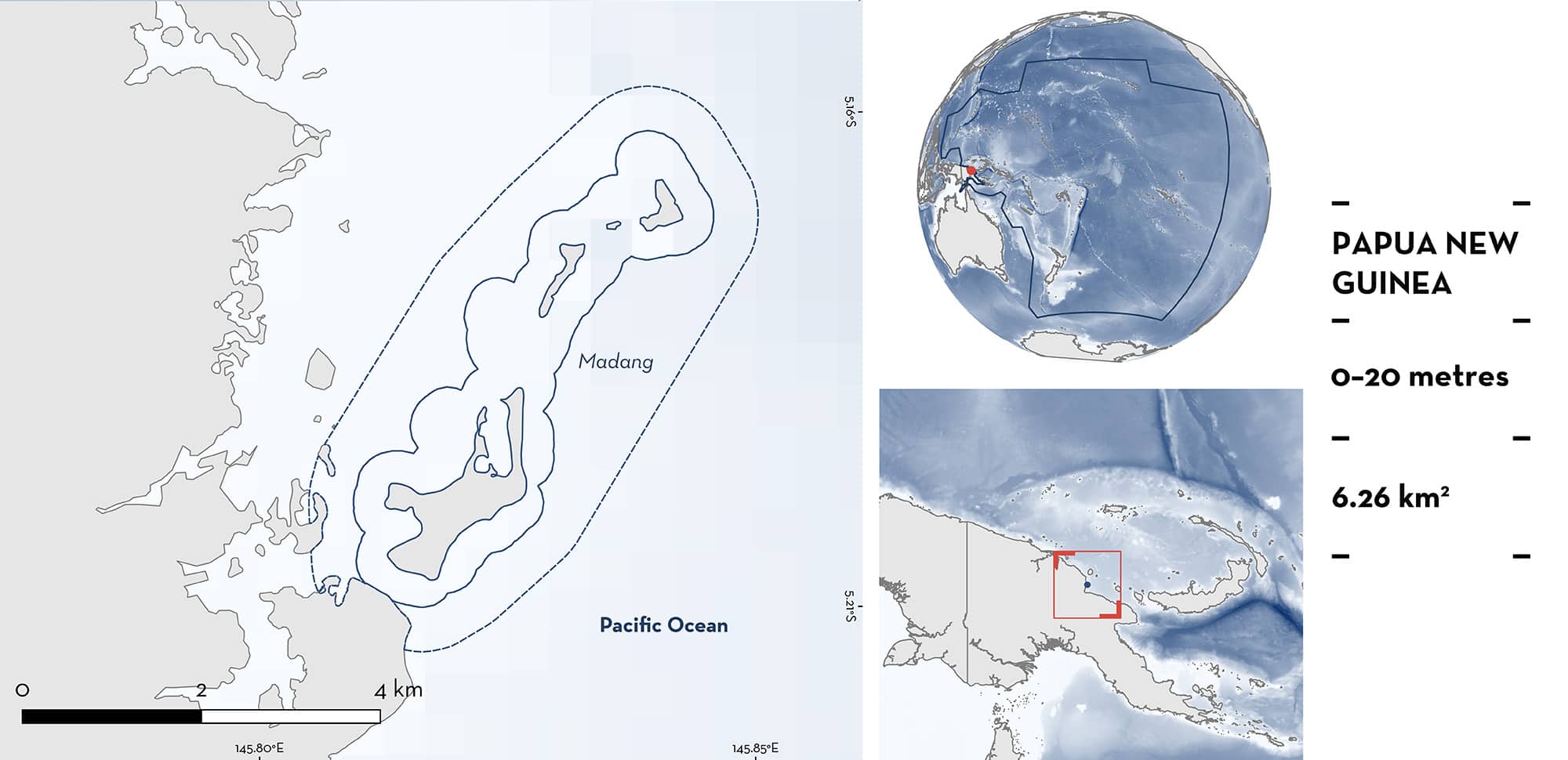ISRA FACTSHEETS
ISRA FACTSHEETS
NEW ZEALAND & PACIFIC ISLANDS REGION
Madang
Summary
Madang is located on the north coast of Papua New Guinea. The area encompasses the waters surrounding the islands of Kranket, Paeowa, Masas, and Tab. The area is characterised by rocky substrates, seagrass beds, channels, and fringing reefs along the edges, supporting high coral cover. The area is influenced by weak currents between October–April. Within this area there are: threatened species and range-restricted species (Hooded Carpet Shark Hemiscyllium strahani).
Download factsheet
Madang
DESCRIPTION OF HABITAT
Madang is located on the north coast of Papua New Guinea and encompasses the waters surrounding the islands of Kranket, Paeowa, Masas, and Tab. These islands are situated on the eastern side of the Madang Lagoon, part of Madang’s barrier reef that forms the seaward edge of the lagoon, which is 17 km long, 4 km wide, and has a depth of ~25–30 m (Pandolfi & Minchin 1996). The area is characterised by rocky substrates, seagrass beds, channels, and fringing reefs along the edges, supporting high coral cover. A steep-sided, narrow barrier reef marks the lagoon’s seaward border, dropping to depths of 400 m within 1 km of the reef (Pandolfi & Minchin 1996). The area is influenced by water temperatures between 27–30°C and weak currents from October–April with visibility ranging from 10–30 m (Niugini Dive Adventures 2024). The rainy season extends from October–April.
This Important Shark and Ray Area is benthopelagic and is delineated from inshore and surface waters (0 m) to 20 m depth based on the global depth range of the Qualifying Species.
CRITERION A
VULNERABILITY
One Qualifying Species considered threatened with extinction according to the IUCN Red List of Threatened Species regularly occurs in the area. This is the Vulnerable Hooded Carpet Shark (VanderWright et al. 2021).
CRITERION B
RANGE RESTRICTED
Madang holds the regular and predictable presence of the Hooded Carpet Shark as a resident range-restricted species. This species is reported from the area based on recreational divers’ observations during night dives in depths ranging between ~3–18 m (Allen et al. 2016; Niugini Dive Adventures 2024). Hooded Carpet Shark is primarily observed on shallow coastal reefs at night and sheltering in caves and crevices during the day (Allen et al. 2016). Contemporary photographs of the species taken in the area by recreational divers between 2017–2024 confirm their regular presence. Additionally, dive reports indicate that Hooded Carpet Sharks are regularly and predictably encountered in the area, with divers observing up to eight sharks during a one-hour dive (Sharks and Rays 2024). Historical records from the 1990s show that Hooded Carpet Sharks were frequently spotted in the waters near the Christensen Research Station in Madang. During the station’s operation, these sharks were a common presence on the nearby reefs, making them a familiar sight for researchers and visitors alike (MV Erdmann pers. obs. 2024).
This area is considered the premier location worldwide for observing Hooded Carpet Sharks during night dives due to the number of sharks that can be encountered in a single dive and has been highlighted in numerous dive reports and magazines (X-Ray Magazine 2024). Additionally, the presence of shallow reefs and extensive intertidal zones around the islands (Pandolfi & Minchin 1996) creates ideal conditions for the species in this area.
Although the home range of Hooded Carpetsharks has not been formally investigated, it is believed that all nine species of Hemiscyllium have extremely small home range sizes and most individuals likely live, feed, mate, and lay eggs on the same reef where they hatched (Allen et al. 2016; MV Erdmann unpubl. data 2020; VanderWright et al. 2021). The Hooded Carpet Shark is endemic to Indonesia and Papua New Guinea and occurs only in the Indonesian Sea Large Marine Ecosystem (LME) with a small range extending along the northern coastline of Papua New Guinea from Madang to at least Jayapura (in Indonesia) (Allen et al. 2016).
Download factsheet
SUBMIT A REQUEST
ISRA SPATIAL LAYER REQUEST
To make a request to download the ISRA Layer in either a GIS compatible Shapefile (.shp) or Google Earth compatible Keyhole Markup Language Zipped file (.kmz) please complete the following form. We will review your request and send the download details to you. We will endeavor to send you the requested files as soon as we can. However, please note that this is not an automated process, and before requests are responded to, they undergo internal review and authorization. As such, requests normally take 5–10 working days to process.
Should you have questions about the data or process, please do not hesitate to contact us.


